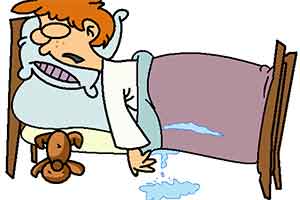New Study Indicates Magnetic Stimulation Effective in Reducing Bedwetting
 Non-Invasive Treatment Shows Promise in a new Restorative Neurology and Neuroscience Report
Non-Invasive Treatment Shows Promise in a new Restorative Neurology and Neuroscience Report
Bedwetting, or nocturnal enuresis, causes distress in children and young adults, as well as for their parents or caregivers. The causes are not fully understood and there may be both physiological and psychological components to the condition. In a new study published in Restorative Neurology and Neuroscience, researchers report that repetitive sacral root magnetic stimulation (rSMS) can reduce the frequency of nighttime bedwetting and improve quality-of-life for sufferers.
In a study conducted by researchers at the Assiut University Hospital, Assiut, Egypt, 41 patients experiencing nocturnal enuresis were divided into two groups receiving either real magnetic stimulation or a sham stimulation using the same equipment and procedures. The identities of the real vs. sham patients were unknown to both the researchers and the patients. Each participant received 10 sessions, five per week. A magnetic stimulator was placed over the sacral vertebrae in the lower back and 15 Hz pulses were applied for 10 seconds on and 30 seconds off. For the sham procedure, the stimulator was internally adjusted so that little magnetic stimulation could reach the underlying tissue. All patients had been taking the tricyclic antidepressant drug imipramine (25mg once at night /day) for at least three months without satisfactory results and they continued taking their prescribed medication throughout the study.
“It seems likely that rSMS produced some of its effect in the present patients by a direct effect on bladder control,” explained lead investigator Eman M. Khedr, MD, Professor, Department of Neurology, Assiut University Hospital. “In the present study rSMS could have increased arousal or enhanced inhibition of neuronal re-uptake of noradrenaline and serotonin. We have previously reported that patients with nocturnal enuresis have pathologically increased excitability and reduced inhibitory processing in the motor cortex and it is possible that rSMS could affect these measures as well.”
The average number of weekly nocturnal bedwetting episodes fell from 5.7 to 0.3 per week after the end of the treatment sessions for the real group compared to 6.5 to 1.8 per week after sham stimulation. Although the sham procedure resulted in improvement (placebo effect), the improvement in the real group continued one month later (1 per week) whereas the sham group returned to baseline behaviour (5.2 per week).
All patients were asked to complete a Visual Analogue Scale (VAS) and a generic Health Survey (SF-36v2). The VAS assesses how bedwetting affects the patient’s life, while the Health Survey measures physical health and mental well-being in eight different health domains.
This treatment resulted in significant improvements in the mental health scores including social functioning, vitality, mental health, and component mental health summation in the real group compared to the sham group. While further trials will be needed to determine the optimum stimulation protocols, the potential benefits to young patients and their caregivers are clear.
Source: IOS Press BV
Full bibliographic information:
“A double-blind randomized clinical trial on the efficacy of magnetic sacral root stimulation for the treatment of Monosymptomatic Nocturnal Enuresis,” by Eman M. Khedr, MD, Khaled A Elbeh,, MD, Ahmed Abdel Baky, MD, Noha Abo-Elfetoh, MD, Dina El-Hammady, MD, and Fatma Korashy, MS. Restorative Neurology and Neuroscience, Volume 33, Issue 4 (August 2015), DOI 10.3233/RNN-150507, published by IOS Press.

